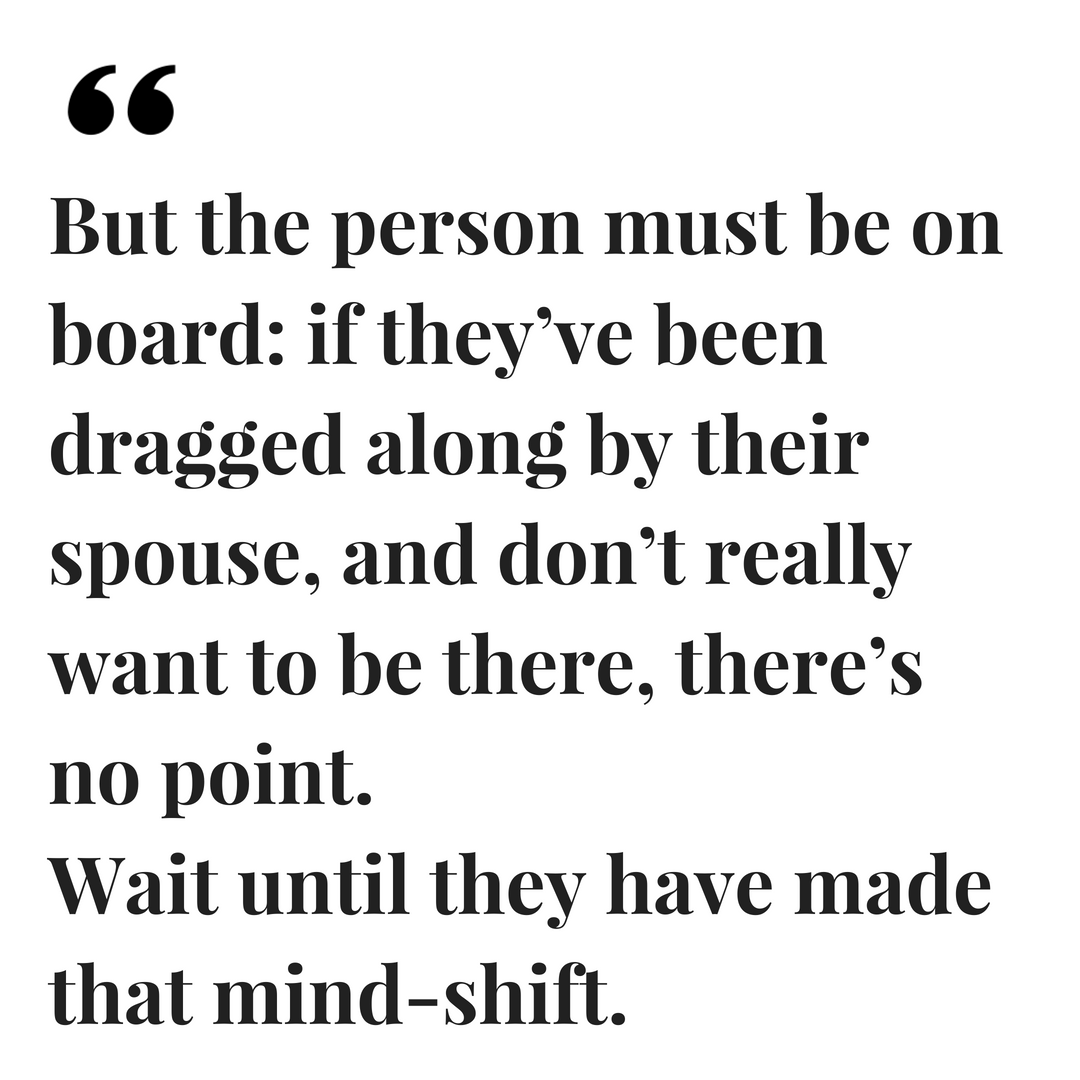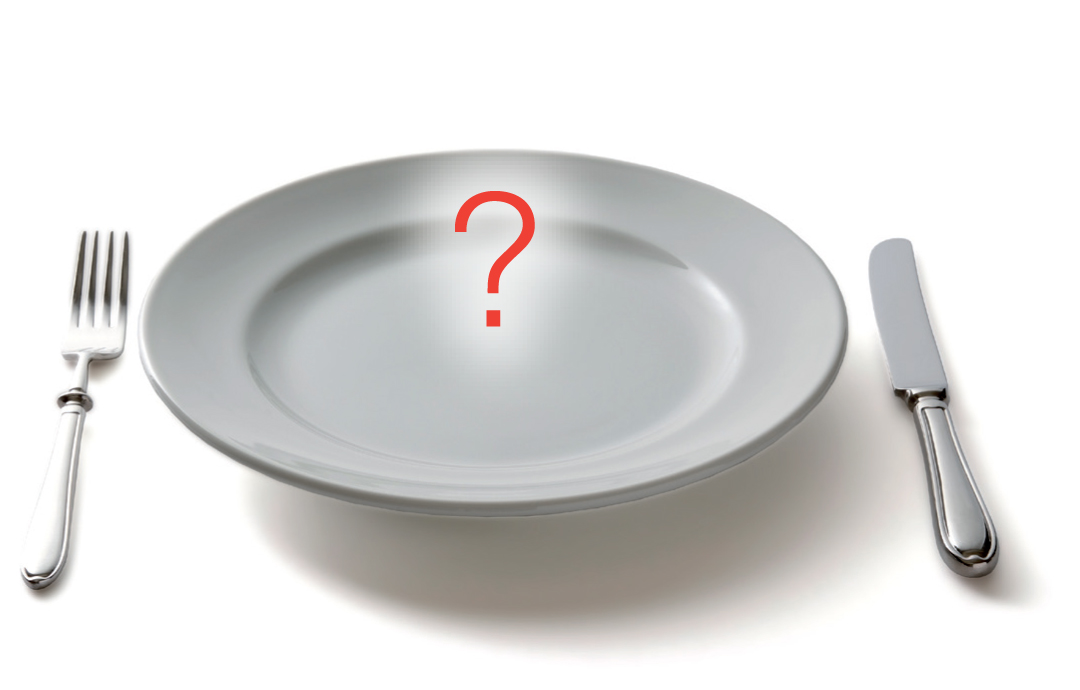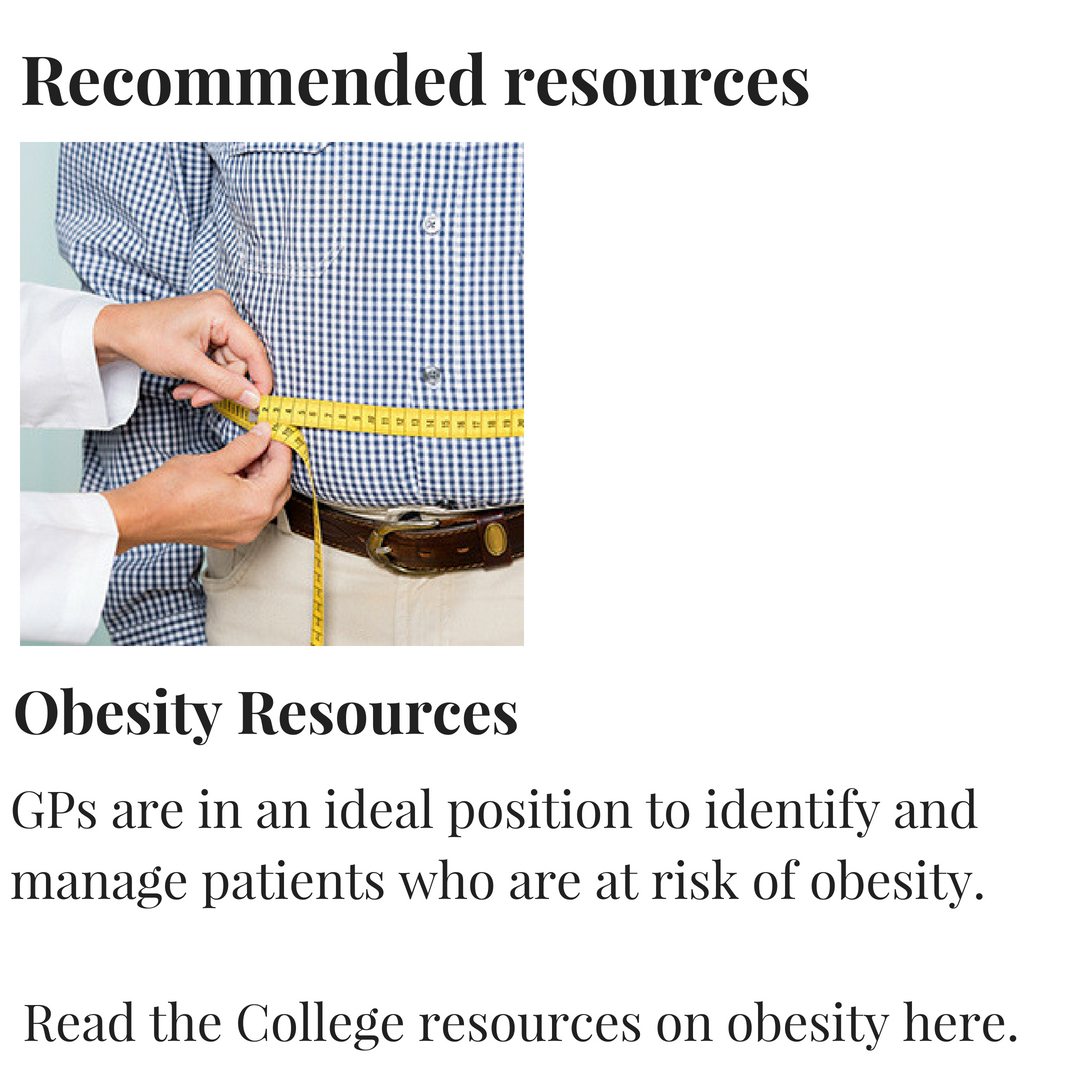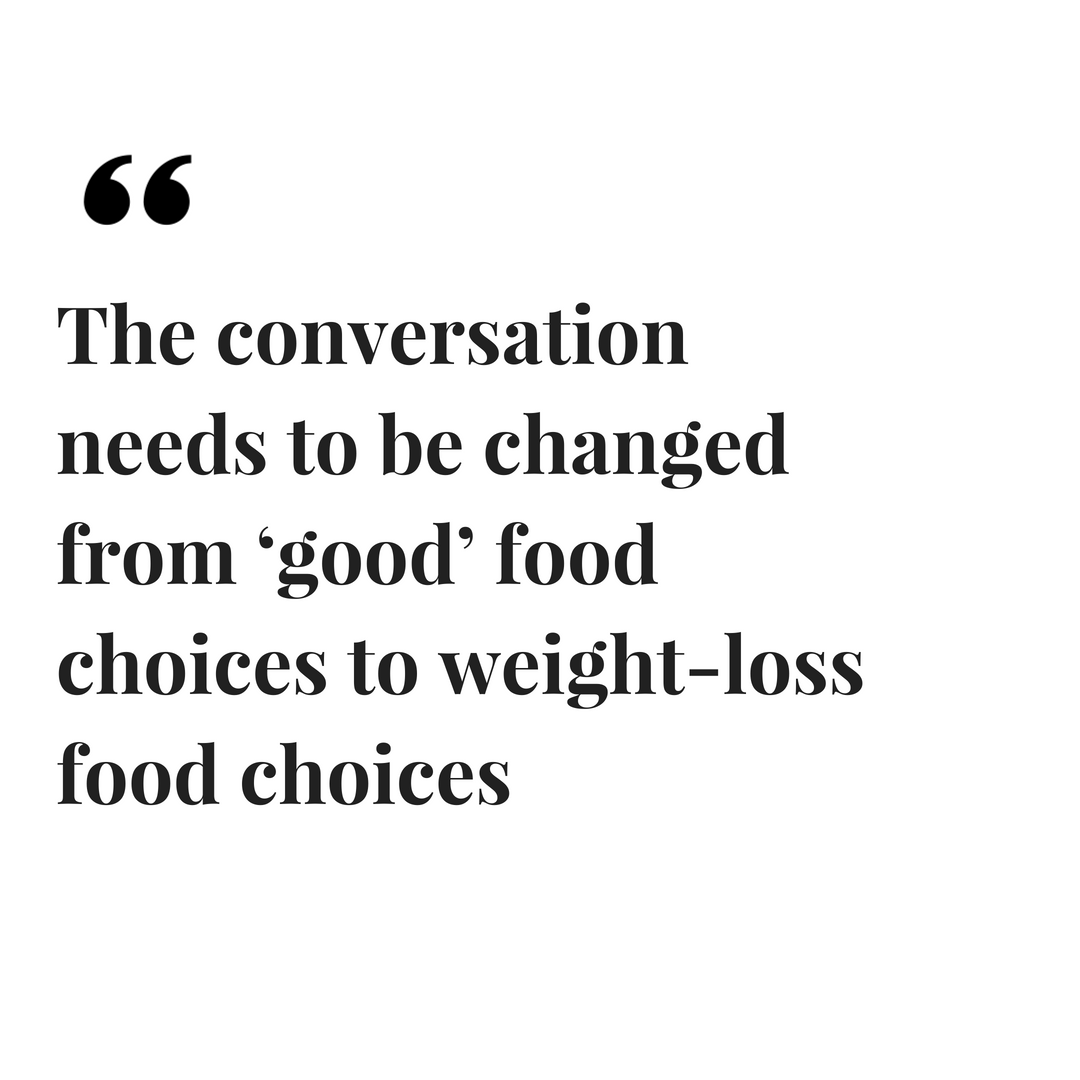Step 1: GPs are major influencers in the weight loss journey
GPs have a really important role in ‘selling’ weight loss the right way to their patients and helping them on their journey. Mary Rose says that painting a positive picture is vital from the start: you can sow the seed for how they can have an exciting change in their lifestyle. You’re going to help them with a pathway. You’re opening the door to a new life for them – better sleeping, lower blood sugar and blood pressure, and improving how they feel.
Your patients will usually ask which diet you believe in, but Mary Rose says we need to move away from talking about diets, as they just aren’t sustainable . Diets are likely to be a temporary measure that put people on a two-year journey of weight loss then more weight gain, and she says the key is to focus on re-setting peoples’ view of what is normal in terms of food and activity.
Most people will complain they eat healthily and exercise but can’t lose weight. The problem, according to Mary Rose, is that they have a distorted view of what is ‘normal’ because our environment has changed so dramatically. We are continually over-served with large food portions, we have access to fast food 24/7, we sit in the office for eight hours, then sit in the car, then sit in front of the TV, and we make it to the gym twice a week: that’s all people know and see, so they think it’s normal.
Talking about the environment in this way takes the pressure out of the conversation: you’re removing personal blame and are acknowledging that it’s tricky for them.

Mary Rose recommends that a GP talks to a teen on their own, without parents present if possible, so that the teen steps up and takes responsibility for losing weight.
For a younger child, she recommends not talking in front of them about weight loss, but working with the parents to change their lifestyle.
Mary Rose acknowledges that weight loss costs money, and that it’s difficult to get public system access to a dietitian.
But she says when people have to pay for weight loss, they more often see results. For people struggling with cost, she recommends they ask the dietitian whether they do groups.
Step 2: Focus on hydration with water
Thirst is one of our least developed senses: a thirsty person will often present as a hungry person. Good hydration with pure water is the first step in giving a person appetite control in an overeating/ under exercising environment.
A person should drink one to 1.5 litres of water per day in summer, one litre in winter. Larger people, and people who are exercising need more. Tea and coffee doesn’t count for hydration, as they are diuretics.
It’s helpful to set up a plan for hydration to help with success. If someone drinks two glasses a day, suggest they drink four a day, and increase it gradually. Get them to specify whether their water will be in a glass or a bottle, how much, and when. Will they carry it in their bag, have it by their desk or bedside, or have it with their meal?
Mary Rose says that pure water is the best fluid for hydration. Some people say to her that they don’t like water, which she finds incredible, and she is adamant that they must stop treating sugary drinks, energy drinks, and flavoured water as normal, everyday things: these all have calories that will help you put on weight over many years.

Mary Rose advises reducing artificially sweetened drinks too, as recent studies suggest they may make it easier to gain and retain weight.
“I’ve never had anyone say they lost weight when they switched to no-sugar coke
Unsurprisingly, alcohol has calories: a 200 ml glass of wine a day will put 9kg on you in a year. Again, people have a skewed perception of what is normal, and think that half a bottle of wine a night is ok; it probably isn’t, if you’re looking for weight loss. Alcohol makes you hungry by dropping your blood sugar, possibly for 24-36 hours. People often ask which alcohol is ‘better’, but Mary Rose says the appetite stimulating factor is similar in all alcoholic drinks. She suggests keeping alcohol to the weekend.
Step 3: Daily physical movement
For overweight people, exercise is only 20 % of the weight loss equation, although it does play a larger role in keeping weight off.
You commonly hear overweight people say they exercise for hours but get no weight loss benefit. Mary Rose says this is because it might be making them too hungry: the exercise needs to be shorter, about 30 minutes. People are relieved to hear this. If they have been overweight for a number of years, they tend to have a high muscle mass, and they’re just maintaining this big engine in a cycle of exercise, hunger and over-eating. Injuries can dishearten overweight people trying to exercise, but Mary Rose says it actually has a silver lining, because it stops them from overdoing the exercise and having to battle hunger as a consequence.
A brisk walk is fantastic for an overweight person: it’s free and can start immediately. Intensity is key: it needs to be fast walking pace, 3.5-4 kms in 30 minutes. They can start off with a 10 minute walk each day, scheduling it in like an appointment. Encourage them to walk first thing in the morning, or before they get home from work, not leave it until afterwards when their resolve will be weakest. For the very overweight, a Fitbit or step counter can be a good motivational tool to gradually build up exercise levels.
Step 4: Three meals a day at set times
A key factor in appetite control is three meals per day – breakfast, lunch and dinner – evenly spaced over the day and this keeps snacking to a minimum. The timing of the meals is quite important: Mary Rose suggests breakfast at 7-8.30 am, lunch at 12-1.30 pm, and dinner at 5.30-7.30 pm. She says large gaps between meals promotes over eating. If people say they don’t feel like breakfast, they’ve probably eaten too much after 4 pm the day before, so you could recommend they reduce portions in the later part of the day.
|
| |
Step 5: Keep a diary, and check in
Keeping a food and activity diary helps with mindfulness and accountability, and moves people away from their old routines. You can recommend an app like MyFitnessPal, but sticking with paper is good because people can leave it by their bed and fill in the day’s intake and activities before going to sleep, and you can scribble pointers on it. The diary helps them work out where they’ve gone wrong and how to do better. If you don’t have time to talk to a patient, just getting them to keep a diary is a good tap on the shoulder and can be quite effective on its own.
Arranging a check-in with your patient seems to be very helpful in weight loss: if the check is done weekly, the weight loss is highest, about a kilo a week. A fortnightly check-in generally shows a kilo a fortnight. And a three-week check-in often doesn’t show a weight loss at all. Mary Rose’s clinic has an open hour where people can drop by for a check-in.
Steps 6-8 cover the basic types of food that it’s useful to talk about: protein, fat, and carbohydrates. Mary Rose says a good way to describe them is to use the analogy of toothpaste, soap and shampoo: they all clean the body, but in different ways.
She divides a plate up into quarters, and shows that for a normal diet, a quarter should be green vegetables, a quarter protein, a quarter white carbohydrates, and a quarter other, coloured carbohydrates. For weight loss, the green vegetables portion expands to half a plate (effectively unlimited), and the other portions shrink accordingly.
Putting both a carbohydrate and a protein together in a meal gives the longest full feeling, because the combination creates an extra-low glycaemic index.
Step 6: Carbohydrates
There are three basic groups of carbohydrates: sugars, starches, and green vegetables. They are our bodies’ preferred source of energy, but they’ve also changed the most over time, becoming highly processed, packaged, and easily accessible.
It’s a misconception that carbohydrates are bad for weight loss: weight for weight, potato, rice or bread are half the kilojoule content of meat, so it’s important to keep carbohydrates on the plate. If you don’t get enough carbs, your body will start using amino acids for energy, so your protein is not being utilized efficiently.

Mary Rose says that conversations with people wanting to lose weight need to be framed as what foods are good enough for them for where they want to go with their weight.
We need to be clear that biscuits, for example, need to go back on the shelf as a luxury item, and are used only on an occasional basis.
We need to encourage people to eat more green vegetables: they’re an unlimited item in terms of intake for weight loss. If you have enough greens on your plate at lunch and dinner, crunchy, lightly cooked, varied greens that you have to chew, as opposed to smoothies that you simply drink, you’re less likely to be overweight.
Chewing helps you feel full. Mary Rose says she often encourages clients to cook more vegetables at the evening meal, for lunch the following day.
Step 7: Protein
Protein is the most satisfying food . Animal protein is the densest protein – around 25%. Beans, lentils and chickpeas have 7% protein. Dairy products also contain protein, and people are usually relieved to hear that yoghurts – even non-diet ones – have a place with weight loss: they’re thickened, so they feel luxurious to eat, and stave off hunger. But cheese gets put on the back-burner for weight loss because of its high fat content.
People assume that handfuls of nuts, and trendy foods like chia seeds and avocados, are healthy, but Mary Rose steers people away from them as nuts are 50% fat, and chia seeds are 33% fat, which is a real calorie booster. Half an avocado has as many calories as three slices of bread.
Step 8: Fats and Oils
People ask about good fats and bad fats, but Mary Rose says it’s pointless to draw the distinction if you’re overweight, because all fats are very dense in calories. Two teaspoons of oil per day would put 5 kgs on you every year, in fact it’s a very good way to improve weight gain in the elderly, by drizzling oil on their vegetables.
Mary Rose is mystified as to why coconut oil is so popular and seen as healthy, because it is actually 92% saturated fat. In comparison, old-fashioned lard is only 42% saturated fat.
Fresh salmon, again seen as healthy, is actually 25-35% fat, which makes it a poor choice for weight loss. But tinned Canadian wild salmon is a much better option, as it is only around 6-8% fat.

Mary Rose says that once people understand this, it’s quite remarkable how they can use it to lose weight.
Step 9: Portion size
We are consistently over-served with portion sizes, and Mary Rose says as a nation we have to get protective about our portions, and reduce the size. A smaller plate is a useful tool to help reduce portion sizes.
We have also forgotten that portions should be different sizes for people of different ages and genders: women, children and the elderly need smaller portions. As an example, she recommends women have thinly-sliced sandwich bread, and men have toast-sliced bread.
Mary Rose also says that snacks are promoted heavily, driven by a highly competitive market presenting processed, sugary, salty, fatty snacks as an everyday norm. Snacks need to be kept small, and of good nutritional value - a portion of fruit with a pot of yoghurt will keep hunger at bay for 2.5 hours, compared to just 20 minutes for fruit alone. She recommends a milky drink mid-morning as a snack for women.
Step 10: Look after yourself
This step acknowledges the reality of trying to lose weight in an environment that is ruthlessly marketing to you regardless of your health issues. Mary Rose says that people need to look after themselves, and make little tweaks all the time to their food intake as their weight loss progresses, so that they aren’t still feeding the big person they used to be. She says with a lifestyle rather than a diet approach, no food is completely off the table, and you can always compensate the following day.
Related links
Journal of Primary Health Care articles:
How General Practitioners talk about overweight and obesity in New Zealand
The complexity of food for people with multiple long-term health conditions